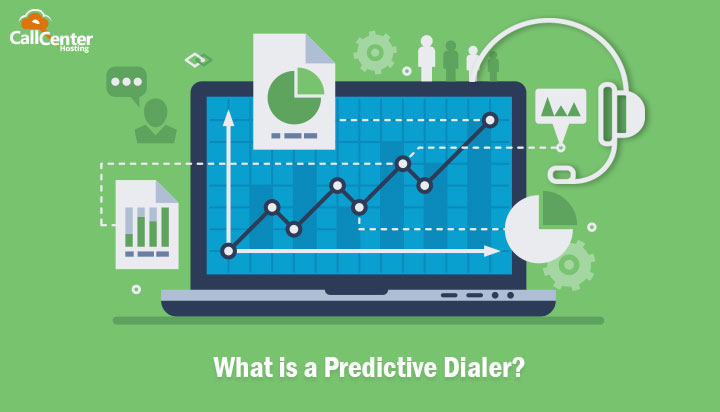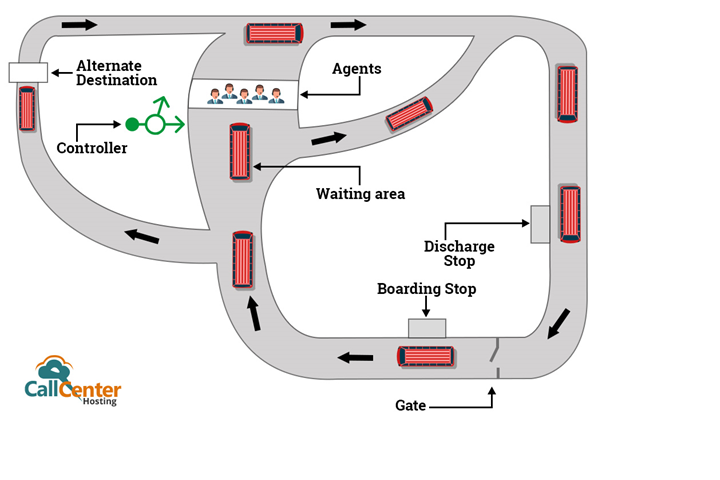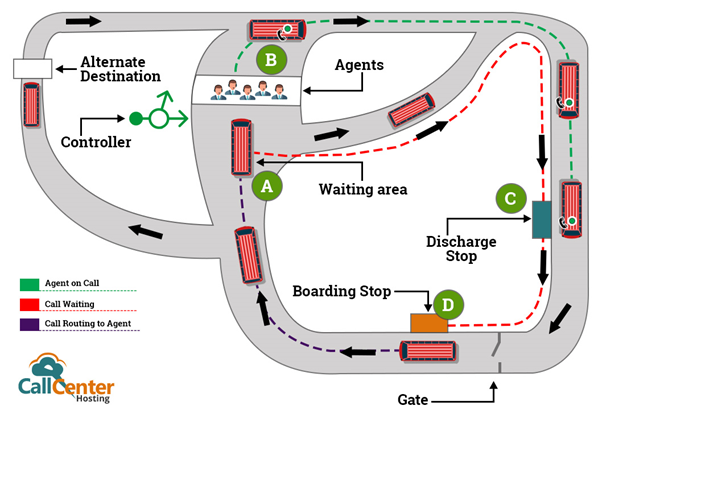What is a Predictive Dialer?
Customer service environment has seen rapid transformations in the recent years. The introduction of technology, such as cloud and data analytics, has impacted the pace and shape of this transformation in customer support methodology.
A predictive dialer is a tool that has gained positives from this transformation and improved agent-customer connections grow higher in number and be more productive. Eventually, it further leads to higher number of sales.

Hosted predictive dialer reduces the effort behind the connecting agents to the customer. How it does it, let’s go into detail.
We’re going to dig deeper into hosted dialers, but feel free to jump to any section that interests you:
→ Predictive Dialer Definition
→ The Three Different Dialer Mode
→ Feature Comparison: Auto Dialer vs. Predictive Dialer
→ Benefits of Predictive Dialer
→ Predictive Analytics in Call Center Environment
→ How the Predictive Dialer Algorithm Works
→ Factors to Consider While Choosing a Predictive Dialer
Predictive Dialer Definition
A predictive dialer software is an outbound calling system that works on an intelligent algorithm that uses customer data such as phone number and demographic details to connect with the customer. Predictive dialing is a more advanced method for outbound call center solution, but it also performs the regular methods for making outbound calls such as power, progressive, or preview dialing.
It also filters out busy signals, voicemails, and dead phone numbers and passes the call to live agents as the customer answers the call. – Source
Three Different Dialer Modes
There are mainly three types of dialing modes in a call center:
1. Manual – The manual dialer is a traditional way of dialing that needs human efforts to dial the numbers, manually.
2. Auto – The auto dialer allows you to feed the dialer with customer data then it dials the customer contacts automatically at a predefined calling rate.
3. Predictive – The predictive dialer is an advanced auto dialer software; your call center agents no longer have to manually dial numbers, or deal with voicemails, busy signals, wrong or disconnected numbers. A predictive dialer can be entirely hardware-based, cloud-based, or their integration with other call center setup. A cloud-based predictive dialer provides the functionalities of a traditional predictive dialer without requiring installation on the local device and reduces the dependency on the hardware.
Feature Comparison: Auto Dialer vs. Predictive Dialer
Here is feature listing for the two.
| Features | Auto Dialer | Predictive Dialer |
| Device Type | Software | Software |
| Automatic Dialing | Yes | Yes |
| Recording of Messages | Yes | Yes |
| Call Waiting | High | Low |
| Routing of Calls | Yes | Yes |
| Data Mining | No | Yes |
| Time Management | No | Yes |
| Agent Availability Check | No | Yes |
| Algorithm Based Dialing | No | Yes |
| Customization (based on time & demography) | No | Yes |
| Wasted Calls | Yes | No |
| Lead Management | Yes | Yes |
| Down Time | Yes | No |
| Frequency of Call Connection | Low | Very High |
| Idle Time | Yes | No |
| Average Number of Calls Answered | Low | Very High |
| Price | High | Low |
| Overall Productivity | Low | Very High |
Benefits of Predictive Dialer
The benefits of this outbound dialer make its role more significant and result oriented. There are several features help in making the most out of the available resources, such as budget, technical capabilities, human force, etc.
- Enhanced Productivity – Reduces the agent idle time substantially since it connects the agent on the call only after connecting to a human agent. So, not only the effort of dialing is saved, but also the time spent ring and voicemails is eliminated.
- Higher Precision – It connects to the agents with much higher precision and higher frequency than a manual or auto dialer.
- CRM Integration – Integrating predictive dialer with CRM software helps in managing the customer information seamlessly and making the best use of it.
- Sales Acceleration – It connects to a higher number of customers which lead to more number of sales opportunities.
- Customer-friendly Calls – The demographic details of the customers that help in making the dialer decide, appropriately when to make the outbound calls for the better possibility of a connection.
- Cloud Platform – The support of cloud technology helps in saving cost and time, improve productivity and avails the updated data in real-time.
- Lesser Call Abandon Rates – A significant drop in call waiting time leads to lesser number of call abandon rate.
Predictive Analytics in Call Center Environment
Predictive analytics signifies a branch of analytics that deal with predictability to business instances at various stages and department. It has touched the core of every industry to help in automating various operating and making a data-driven decision.
Predictive analytics has its influence on the call center operations as well. It can improve customer relationship management by offering powerful insights to understand the customer lifecycle. Every customer is unique but there are certain trends or patterns using which their behavior can be predicted and can be used to improve communication with them, in terms of both – experience as well as productivity.
Predictive analytics works on a certain algorithm. The precision of this algorithm ensures its’ effectiveness.
The Algorithm of Predictive Dialer
It operates on an algorithm that uses the agent performance metrics and predicts the best time to initiate a call while another call is already on. With such data-driven predictions, the dialer speculates the free or idle time of the agents and further connects them to the customers.
Douglas A. Samuelson, known as the inventor of predictive dialing system, designed it in such a way that the dialer initiates a new call in advance. He cited that there are mainly two critical points that make the grounds for predictive dialer generating a call.
- Prediction of the number of free agents when the dialer initiates the call.
- The probability of success of the calls to connect to the customers.
The performance of this call center dialer is measured based on two principles-
- Maximize agent utilization time
- Keep the calls in such threshold that the number of calls made should not exceed the available agents.
The fundamental idea behind this dialer is to anticipate when the representative will complete a call and to time new outbound calls so that the agent could answer the next call without spending any idle time.
So, the dialer starts a new dialing attempt in every ‘n’ seconds. This ‘n’ is ideally kept between 3 to 10 seconds.
Although initially, the users thought that the best way to keep the representatives busy is to make the calls all the time on every available line. However, this led to a high number of abandoned calls. In general, most of the call center managers want to keep the abandoned call under five percent of all the completed calls.
So, the most necessary point is to estimate the time remaining until the service call completion. For example, if it is known that the communication with the agent will last for the next 30 seconds and the called party takes 15 seconds to answer a call once the dialing starts. In this case, this outbound dialer system will start dialing after 15 seconds from now despite an ongoing call.
Moreover, sometimes the dialing attempt may have no answer. So, it is equally necessary to attempt more number of calls, simultaneously. But the question here is, what should be the number of call attempt at a time. Because, if none of the calls answered then it adds to agent idle time. The number of call attempts at a time is an important decision variable.

Figure 1
Samuelson used an analogy to explain his idea of predictive dialing. He took the example of buses as outbound calls. As the above pic depicts, the buses (outbound calls) are attempting to board the passengers on. These passengers are the called parties.
There are mainly three destinations to the buses. The first one is, buses board the passengers that mean the called party has answered the call.
The second alternative is, the buses take a different route and reach an alternate destination without any passenger. This destination includes situations like busy, no answer, or any recorded message on an IVR.
Let’s understand the third destination. In figure 1, we see that a road has connected the discharge stop and the boarding stop. The time duration to cover this distance is important because during this time if we correctly time the bus or attempt a well-timed outbound call, we have to board the passengers and take them to the available agents.
So, these buses have to board the passengers to the maximum number and take them to available agents. Now there are two conditions –
- The bus should leave at the right time with speculation of the time when an agent gets free form the customer conversation.
- When the bus has found a passenger (call connected to a customer) there should be an available agent.
As we see in the diagram, there are several nodes, such as discharge stop, boarding stop, alternate destination, controller and waiting area. Let’s try to understand these terms with clear ideas.
Boarding stop [B]- This is the point where the buses meet the passengers means call connects to the customers.
Discharge stop [c]- This is the point where agent completes the call.
Controller- Controller is the point that decides when to release the next bus or when to dial the next call.
Alternate destination- Bus takes to an alternate destination or call goes to busy, no answer or an IVR.
Waiting Area [A]- The boarded passenger or the customer has to be taken to the available agent. This area depicts the duration between call connection and agent response.
This dialer uses some vital data such as, duration of the call, the proportion of dialing attempts that result in an answer and duration of successful dialing attempts.
This data helps in taking various decisions such as,
- There is an estimated time of service that an agent usually takes to serve a customer. When the agent is speaking with a customer, this data speculates the time left in comparison to the estimated time.
- Deciding if the estimated time remaining in the service is less than the time needed to connect with a new customer.
- If the number of call attempts made is higher than the available agents to answer the customers.

Figure 2
Let’s consider figure 2. In this figure, we can see there are several buses (outbound calls) that need to board passengers (Customers) at the boarding stop point D and take them to the waiting area point A.
Here, we can see other two points, controller, and alternate destination. When the customer is boarded on the bus, it can either go to connect with the agents after crossing the waiting area, or it can go to an alternate destination such as, busy, no answer or an IVR.
Let’s consider the scenario when the customer has boarded the bus at point D – the call has connected. Between point D and A, the call is routed to the available agent.
At point B, the agent is connected to the customer. From point B to C the agent speaks with the customer. C is the discharge point where the call ends, or the passenger gets off the bus.
The time spent between B and C is critical because this is the call handling time of the agent.
The controller has the authority to release the next bus so that it can reach the boarding stop D where passengers are waiting. In other terms, it is essential to start a new call after estimating the time left in closing the previous call by the agent.
At point C, we have a free agent. Between point C and D, this is the time duration when the agent is idle. And again, at point D, the bus finds a passenger, or an outbound call connects to the customer.
Here, it is necessary to understand all the dotted lines in the figure depict a span of time. And three mutually dependent activities happen during these time spans.
- Ongoing call with agents (B to C)
- Call routing to the available agent (D to A)
- Outbound call attempt in the background of an ongoing call (A to D via C)
The controller has to decide to start a new call based on all these time spans, and this decision making is the algorithm of this hosted dialer. It reduces the agent idle time span between C and D, substantially.
What all Factors You Should Keep in Your Mind while getting a Predictive Dialer
Various points are necessary to consider when you get a predictive dialing system for your call center business. The list of some of the factors are given below,
- Dialing Ratio – Calling rate is an important factor. It means the number of calls the dialer place in a unit time depending on the number of available agents.
- Call Reporting – Should provide extensive reports based on the call data. This data helps in judging the performance of the agents.
- Time Zone Based Calling – Once you feed in the time-zones and demographic details of the customers, it chooses a time to make the outbound calls according to the time zones of the customers.
- Ringing Strategy – There are several types of ringing strategies that help in controlling the pattern in which customers are connected to the available These ringing strategies include ring-all strategy and memory round robin. In-ring all strategy, all the agents are notified simultaneously, and in case of round robin, the agents are notified about the connected call one after another.
- Lead Management– Lead management feature helps in managing the leads with all the information handy.
- Skill-based Routing– This feature helps in providing the best solutions to the customers as the customer is directed to the right-skilled agent, immediately.
- Customizable Options– Various customizable options help in making the customer information more specific that one can further edit or add as per the need. For example demography, time zone and other information like email or additional number.
- Integration Capability– It can integrate with business applications that enhance its potential many folds as the information sharing between apps is automated and error-free.
Predictive Dialer: A Call Center Tool with Futuristic Capabilities
It is a tool that completely supersedes the contemporary needs of making flawless outbound calls. In addition to this, such dialers equip all the needed features that support the idea of the maximum number of a call connection with the customers.
A predictive dialer ensures that a call center should be able to get the best output of the efforts made behind the customer-agent connection.
There are plenty of opportunities to make the most out of the customer-agent conversation. A hosted dialer is an easier way to find these opportunities and reap the best benefits out of it.
Final Note
I hope the article offers ample information about what predictive dialer software is, how it operates in the competitive call center environment, and how it can help your call center generate more sales and customer connections.
If you still require more assistance to understand this software, you can opt for a free trial of the hosted predictive dialer. You can also contact a solutions consultant at 1-800-346-4974 and claim a free consultation.
References
- Predictive Dialing for Outbound Telephone Call Centers
- How Analytics, Big Data, and AI are Changing Call Centers Forever
- What is Predictive Analytics? Transforming Data into Future Insights
Latest posts by Vipul Srivastav (see all)
- Why is the Contact Center as a Service (CCaaS) a Business-Oriented Model? - March 2, 2020
- How Your Support Team Can Benefit From Quality Assurance - February 26, 2020
- 5 Things Every Entrepreneur Needs to Know About International Toll Free Numbers - February 24, 2020








Leave a Reply
Want to join the discussion?Feel free to contribute!